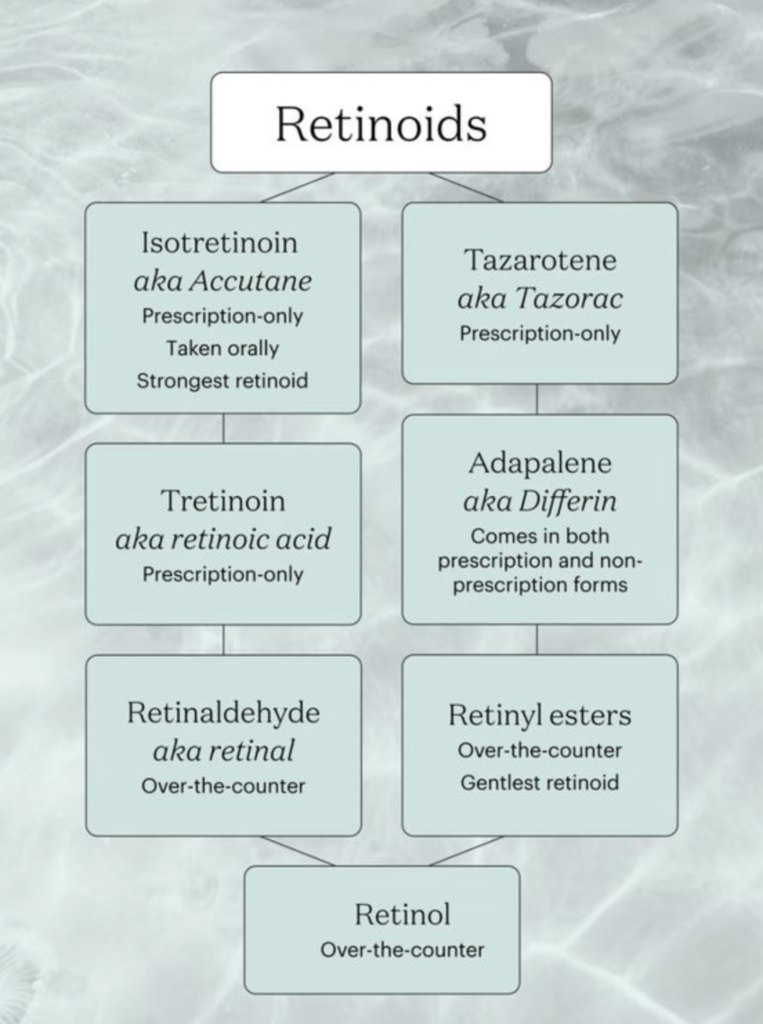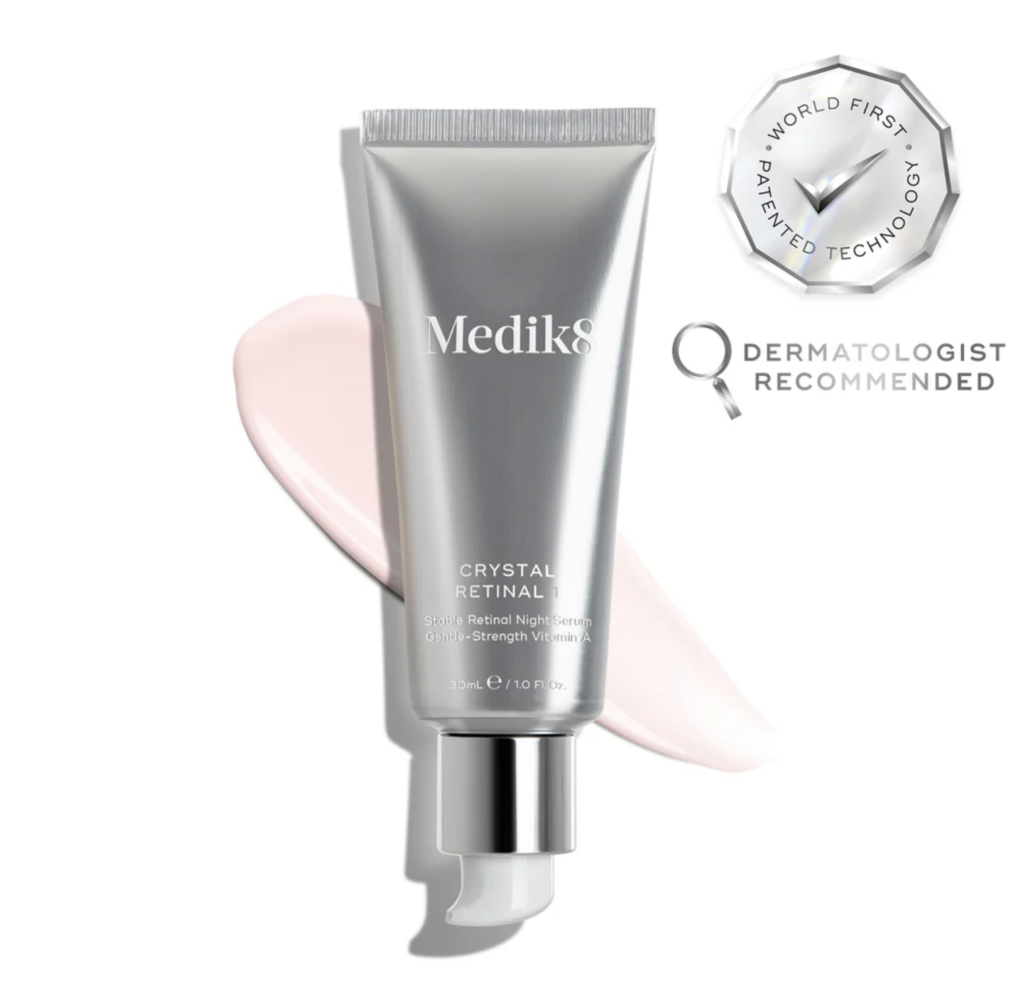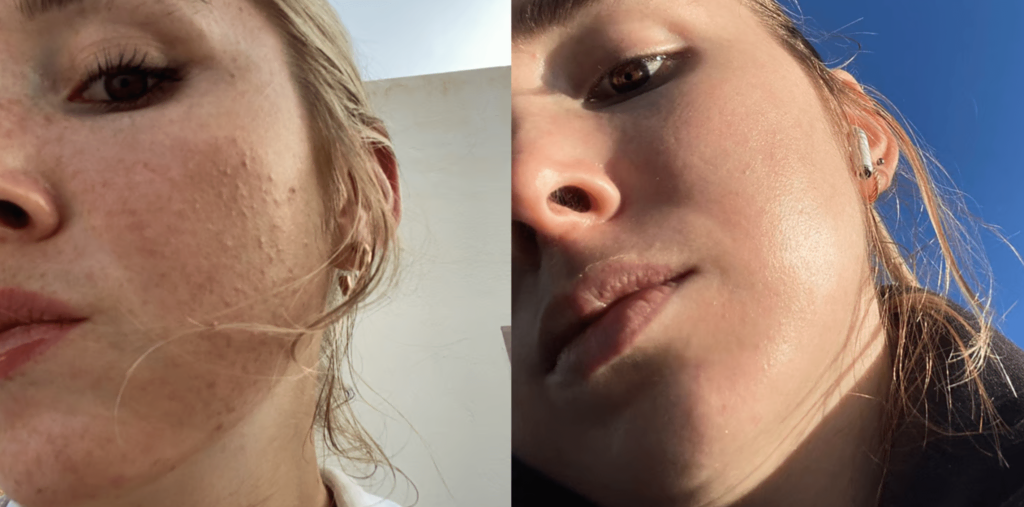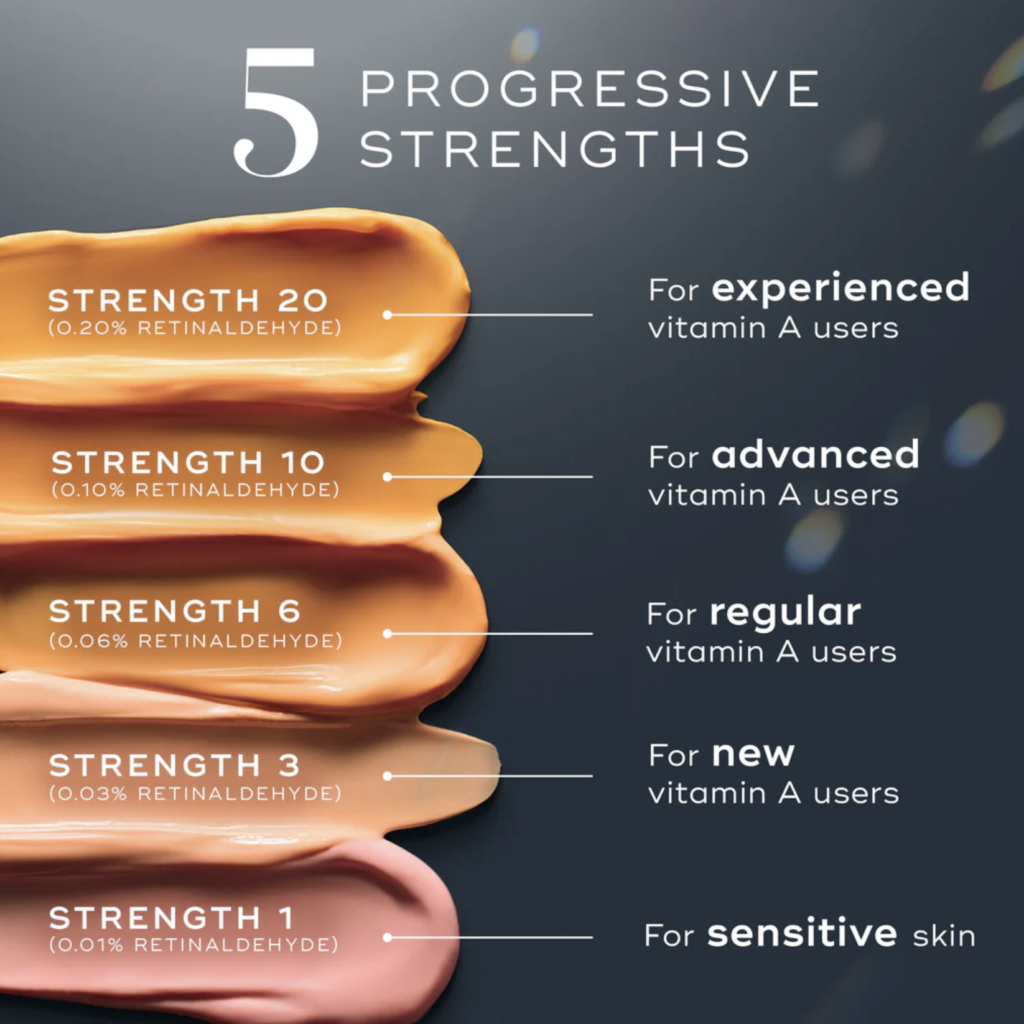This site contains affiliate links. I may earn a small commission, at no extra cost to you.
In this blog post I’ll write up my Medik8 Crystal Retinal review and explain the difference between retinaldehyde vs retinol, otherwise known as retinaldehyde.
This blog post is kindly sponsored by Medik8. However, their Crystal retinal has been on my best retinoids for clogged pores recommendations list long before they had approached me to work together.
Their retinal serum is one of the first retinal products to become available, many years before retinal increased in popularity like it has recently.
Medik8 Retinol Review
To kick off the Medik8 retinol review, I will actually correct ‘retinol’ to retinal because that’s what this is – a retinal night serum.
You’ve probably heard about retinal in several skincare products, have come across the Medik8 skincare brand and want to know more about this particular vitamin A derivative.
To explain it simply, retinaldehyde is a form of vitamin A. Vitamin A products speed up the skin cell cycle, causing the skin to renew itself much quicker than normal. They can range from entry level (such as Medik8’s 0.01 retinaldehyde, Medik8 Crystal Retinal 1) to much higher strengths, like Medik8 Crystal Retinal 24!
Different types of retinoids

To compare retinaldehyde vs retinol, let’s start by understanding the key differences between different types of retinoids. Generally speaking, ‘retinoid’ is the umbrella term. If someone says they use a retinoid, you therefore cannot be sure of which one they use.
You’ve probably heard of retinol most commonly. Retinol is a cosmetic (non prescription) retinoid. If you walk into Boots or Superdrug, most retinoids you can pick up there will be retinol products.
You may also have heard of retinyl esters and retinyl palmitate. These are often grouped together with cosmetic retinol. They are also forms of retinoids that can be bought over the counter.
Oftentimes brands will combine some of these together to make slightly more powerful retinoid products.

The least commonly found (and the most slept-on type of retinoid in my opinion) is retinaldehyde. The word ‘retinaldehyde’ is often shortened to just ‘retinal’.
Medik8 have found that retinaldehyde can generate results up to 11x faster than cosmetic retinol. Anecdotally, lots of my followers have found this to be true.

0.1% retinaldehyde is actually what got me my initial skin transformation pictured above (the equivalent to Medik8 Crystal Retinal 10).
This is because it’s closer to retinoic acid than cosmetic retinols are. When it’s applied to the skin, it has less conversion steps (things to do to become effective). Retinols have many more steps and therefore loses some power along the way.
When comparing retinaldehyde vs retinol, it’s an easy win for me to recommend retinaldehyde if you’re looking for real results.
Retinaldehyde vs prescription retinoids

On the other end of the spectrum, you have prescription retinoids. You might have heard of tretinoin, tazarotene or adapalene, for example. For most of these, you’ll need a prescription because they are essentially retinoic acid in their purest form.
Although they are strong and therefore very effective, the main drawback people experience with these is irritation. Tretinoin, for example, doesn’t need to undergo a conversion process to become retinoic acid on the skin.
This makes it very effective over time, but it is also known to be very irritating and hard to tolerate.
Whereas with retinaldehyde, it requires a single conversion step to convert to retinoic acid, compared to retinol’s two steps.
This positions retinaldehyde as a really nice middle ground for people wanting fast results without lots of irritation. No matter your skin type, you will likely be able to find a Crystal Retinal strength that suits your skin.
Medik8 Crystal Retinal review

Medik8 made one of the first retinaldehyde skincare products available. When I began posting about skincare in 2022 it was still nearly the only option!
In this sense, they really have been leaders in the space for a while. It has always felt like the Crystal retinal product has a cult following for those in the know.
To begin the review, I’ll start with a refresher of all of the positive changes retinaldehyde can have on your skin.
Retinal for skin texture
You’ll probably have seen the photo of my old skin texture more times than your family (I know, I know). But retinal really is a game changer for evening out skin texture.
Retinaldehyde speeds up skin cell turnover, meaning that your skin essentially replaces itself quicker than usual. This means that any blemishes, texture or pore irregularities get washed away quicker with time and renewed from the source.
Retinal for uneven skin tone

Along with skin texture, uneven skin tone is also evened out. Signs of photoaged skin (sun damage), light scarring, dark spots and acne marks can fade significantly.
The net result is generating the appearance of overall healthy skin.
You may have heard that topical skin care like a vitamin C serum or niacinamide can do a similar thing. Whilst it can definitely help, it does not have the same skin cell turnover effect as forms of vitamin A.
Retinal for signs of ageing
Addressing the appearance of fine lines with topical skin care can be challenging, because barely any popular actives have good quality clinical evidence to prove they’re effective.
However the good news is that retinoids and sunscreen are the two that do have evidence to support this claim.
Therefore, if you’re looking for visible results when it comes to an anti-aging skincare routine, the Medik8 crystal retinal is a really safe choice.
Retinal for persistent acne

Most people don’t know this, but retinoids were actually originally created as an acne medication originally.
Over time, they noticed that these acne patients not only had great results with their acne, but that their skin also appeared to age more slowly.
This is where the association between retinoids and mature skin comes from. Unfortunately it often means that the acne benefits of retinoids are overlooked.
Anecdotally, I’ve had the clearest skin of my life while using retinoids.
I’d therefore really recommend Medik8 Crystal Retinal to anyone looking to address mild to moderate acne, and the appearance of fine lines.
Multiple friends and followers have tried it out and become hooked on the results.
The bottom line on retinal vs retinol
This is why I’m so keen on retinoids and retinaldehyde in particular. We’re not dabbling with trending, ‘fast skincare’ anymore, these are products proven to drive results.
Even a few months of consistent use with Medik8 retinaldehyde can negate the need for lots of the other serums you use. It is simply that effective.
Next, I’ll answer a few frequently asked questions about retinoids and retinaldehyde in particular.
Retinoid strength chart: what’s the right strength for beginners?

I get asked a lot what the ‘best’ strength retinoid is for beginners.
Unfortunately it’s not as easy as there being one ‘best’ strength, since everyone is different. However, I can make some recommendations based on my experience.
If you have sensitive skin, you may be concerned that retinoids will cause some kind of reaction.
I can’t speak for everyone, but I have sensitive skin too and have never actually had much of a reaction from retinoids in this way.
I started with 0.1% retinaldehyde with a (now discontinued) product in 2020.
This is equivalent to the Medik8 crystal retinal 10. It is one of the higher strengths that retinal is available in.
Medik8 are the only brand that have created retinal in a wide range of strengths (five to be exact). They go from 0.001% all the way up to 0.2%!
This is really handy if you like to start lower to put your mind at rest. You can gradually increase without any big jumps.
When to move up retinol strength
However, moving up in retinoid strength isn’t always necessary. It is a myth that you should continually climb up in strength.
My belief is that if you are happy with the results you’re currently getting, it’s okay to stay with that strength until you aren’t anymore.
Below are my suggested starter strengths for different profiles of people and skin types. I would re-type what Medik8 have created below, but I agree with what they’ve written here for the most part.
I will also just add – if you’ve never used any retinoid but have fairly tolerant skin and want to see faster results, I think starting at strength 6 or 10 is a good pick.
How to use retinal in a skincare regimen

I recommend using any member of the retinoid family in a routine the same way. It’s no different for Medik8 Crystal Retinal.
The best way is to start slowly to see how your skin reacts, gradually increasing usage over time.
I generally recommend this schedule:
- Month one: 1-2x per week
- Month two: 2-3x per week
- Month three: 3-4x per week
By month three, you’ll have a good idea of what your skin likes and will be able to intuitively adjust your frequency.
It is recommended, however, for best results to use it at least 3-4x a week after you’ve adjusted to it. This is the same, not matter if it’s retinaldehyde vs retinol.
Using it every day is not always necessary, and certainly not if your skin barrier feels compromised.
Medik8 Crystal Retinal is a really great choice for sensitive skin or skin that feels easily upset.
However, there are still some helpful rules to follow to avoid any barrier disruption.
Skincare ingredients to use with a retinoid

It’s a good idea to temporarily stop using any exfoliating actives such as salicylic acid or glycolic acid etc. It might seem counterintuitive to do so, but it can take the skin a few weeks to adjust.
When you use a retinoid your skin barrier will be tested. You don’t want to damage your barrier by using these while your skin is still getting used to the Medik8.
Active ingredients to discontinue for the time being:
- Salicylic acid (including cleansers) or any BHAs
- Glycolic acid (including cleansers) or any AHAs
- Any cleansers that are exfoliating in any way
- Other retinoid products
- Don’t layer vitamin C with your retinoid and consider stopping it temporarily, as it can also be irritating
- Benzoyl peroxide
- Epiduo or Differin (these are both retinoids in their own right)
Some ingredients to continue using, if you already use them:
- Sunscreen (always use this, especially if you’re going to use acids and a retinoid!)
- Hyaluronic acid is fine to combine with any other skin care ingredients
- Centella asiatica can be combined with most, too
How to apply retinal on face for beginners

Once you get the hang of applying retinaldehyde it’ll become second nature.
For now, I’ll list out my top retinol application tips and mistakes for when using Medik8 Crystal Retinal.
For retinaldehyde vs retinol, the application method is the same.
If you don’t apply retinoids correctly you might see more of the unwanted side effects, so don’t skip past these tips!
This is my preferred retinol application order:
- After cleansing your skin at night, pat the skin dry with a clean towel or tissue.
- Dispense a pea sized blob and spread a thin layer across your forehead, cheeks and chin. Avoid the eye area.
- Allow the Medik8 Crystal Retinal to set up on the skin for 10-15 minutes, then apply your other serums and creams.
Retinoid application mistakes to avoid
To see significant improvement with your skin, avoid these retinoid application mistakes:
- Don’t apply more than you need. It won’t get you better results, only more irritation and dryness!
- Only apply your retinoid at night
- Only apply your retinoid to bone dry skin. If you choose to do the sandwich method, make sure the moisturiser has dried down
How to apply retinol around eyes

My preference is to leave a gap under the eye area when applying retinoids. You can then go back and use an eye cream after. I prefer not to apply the eye cream first, although I can see the logic when people do.
This is because I like to avoid accidentally smudging the eye cream down onto my cheeks. Because I’m acne prone, I notice that this can can happen if you apply a retinoid after eye cream.
However, if you’re a beginner, don’t have this preference or just have sensitive eyes, it may make sense for you to apply eye cream as a ‘buffer’ to stop the retinoid spreading too close to your eye.
Lastly, even if you’re using the Medik8 Crystal Retinal Ceramide Eye cream, I still don’t want this lower than my eye area. Eye creams are usually richer than face serums, and might cause breakouts if they accidentally get onto other areas of the face.
Medik8 Crystal Retinal Ceramide Eye 6 review
Whilst I’m here, I’ll add my mini review on the Medik8 Crystal Retinal Ceramide Eye 6 that I’ve been using. Originally I was using another retinal eye serum that was 0.02%, but I wanted to increase the strength as I just turned 30 and tolerate the 0.02% very well.
Overall, I think it’s a great retinal eye serum – it is hydrating and pleasant to use.
Final thoughts on Medik8 Crystal retinaldehyde vs retinol
Overall, I’ll always recommend Medik8 Crystal Retinal because they really have thought about putting results first for people.
Unlike other brands that often jump on fleeting skincare trends, I really resonate with what Medik8 stands for, and the product is quite simply effective.
One bottle will last a super long time, too (around 4-6 months in my experience) as you only need a small amount – especially when you get the hang of applying it in a super thin layer.
Final thoughts on retinaldehyde vs retinol
When it comes to retinaldehyde vs retinol, retinal is definitely a superior choice for faster results.
This was Retinal vs Retinol? Medik8 Crystal Retinal Review. You may also like:
- Can I use Retinol and Tretinoin Together? Tips & Routine
- Can You Use Differin Gel with Salicylic Acid for Acne?
- What If My Product Contains Pore Clogging Ingredients?